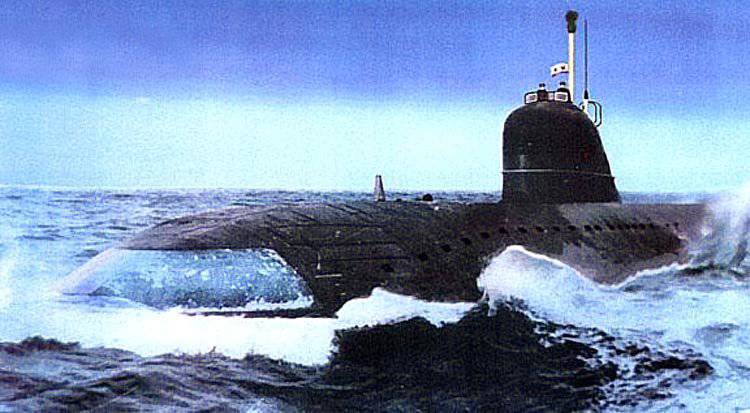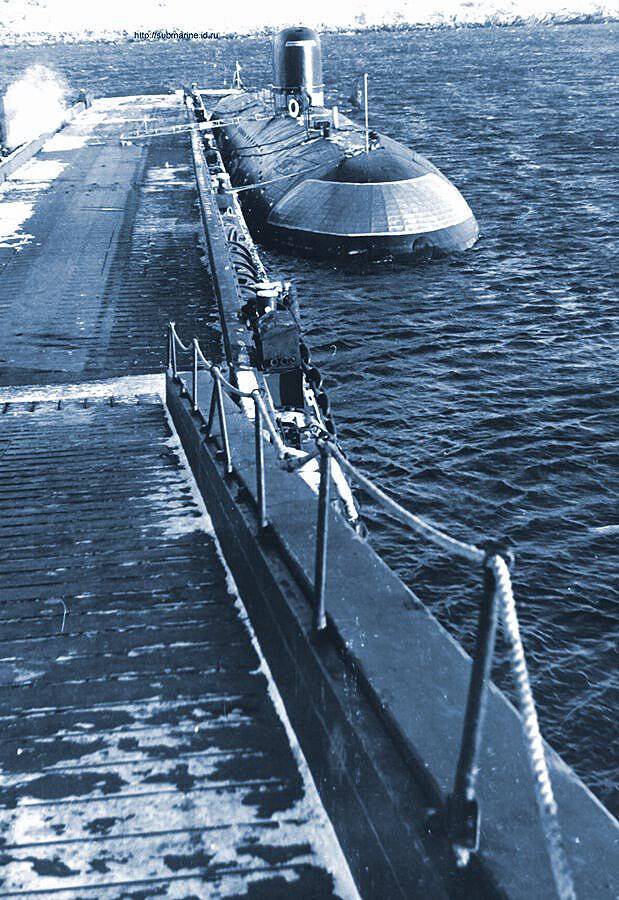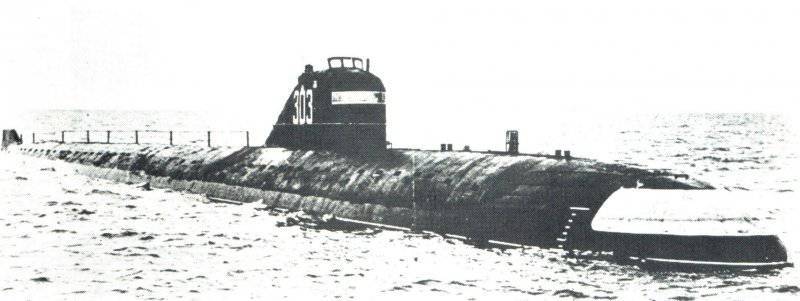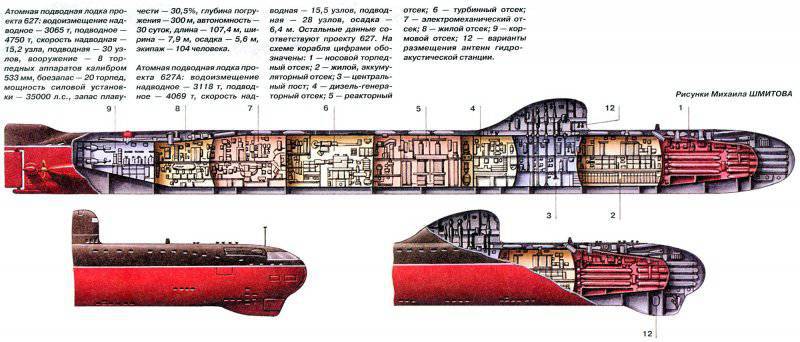Atomic torpedo and multipurpose submarines. 627 project

Naturally, the most difficult problem was the development of a nuclear power plant, which could be placed on board the underwater vessel. The first Soviet purely “terrestrial” nuclear power plant with a capacity of 5 mW was commissioned in Obninsk in 1954 (used for urban power supply). Then they created the first ship reactor (for its time it was the most powerful in the world), which was intended for installation on the “peaceful” nuclear-powered icebreaker “Lenin”. This icebreaker, in fact, was an experienced ship, which served to work out the power ship installation.
Research Institute №8 of the Ministry of Medium Machine Building, under the leadership of N.A. Dollezhal, became responsible for the development of the steam generating installation for a submarine. The steam turbine power plant was designed by the SKB of the Kirov Plant (chief designer Kazak) and SKB-143. The plant "Electrosila" created electrical equipment. Looking ahead, it should be noted that many experts believe that the main drawback of the electric power installation of the first domestic nuclear submarine was mounted electric generators, which worked only in conjunction with the main turbo-gear units. This limited the duration of the vessel being in reverse or on the “foot” with the capacity of backup batteries.
8 March 1956, the launch of an experienced "boat" reactor, which was mounted in Obninsk near Moscow. But “the first pancake was a lump” - due to the design flaw in the reactor lid, there was a leakage of radioactive water. Later the cover design was changed. Requirements for nuclear safety of ship power plants were also not immediately formed. So, for example, at the beginning of 1950's, it was suggested that the overload of radioactive fuel could be carried out on the high seas (of course, accepting such a proposal would cause everyone participating in the operation to be exposed).
The experimental submarine of the 627 project was primarily intended for testing in the open sea conditions of the first model of a nuclear power plant with a steam-water reactor. However, the ship was also viewed as the leading model of a new strategic weapons system designed to combat the main “potential adversary” - the United States of America. The nuclear-powered ship was supposed to deliver nuclear strikes on naval bases, as well as other strategic targets located on the coast. For this purpose, the submarine was supposed to arm the T-15 steam-gas heavy-duty torpedo (length 24 m, caliber 1550 mm, range to 50 thousand m) equipped with a nuclear warhead (the dimensions of the latter determined such monstrous torpedo dimensions). The work of design teams was carried out in an atmosphere of super-secrecy, with the involvement of a very narrow circle of participants. In addition, at the initial stage of the program implementation, practically no naval specialists were involved in the work, which had a bad effect on the formation of the nuclear submarine.

Group V.N. Peregudova in March 1953, the work on the pre-sketch project of a nuclear submarine was completed. The first domestic nuclear-powered ship should have a double-shell architecture with an unusually large (near 13) extension and cross-section that was close to circular. The two-shaft powerplant should have achieved maximum underwater speed over 25 knots. Hydrodynamics of KK took part in the formation of the ship’s architecture. Fedaevsky (TsAGI), as well as VI Pershin (Central Research Institute-45). The boat (for the first time in the USSR) received a "cetacean" shape of the nasal tip, which was optimized for scuba diving, but significantly reducing its characteristics in the surface position. This form of the nasal tip caused a serious discussion among the creators of the nuclear-powered icebreaker (some designers insisted on retaining the “shiplike,” traditional, shape of the nasal tip). However, the opinion of Peregudov, who believed that the nuclear-powered icebreaker must first of all be adapted for diving, gained the upper hand. The oval shape of the nose was later implemented on the US nuclear submarines of the type “Skipjack” (the lead ship entered service in 1959 year), as well as on subsequent nuclear-powered ships that were designed and built in the United States. However, in the Soviet Union it was finally approved only on the second-generation submarines.
In nuclear submarines of the 627 project, compared with foreign and domestic diesel-electric submarines, the maximum depth of immersion increased by one and a half and amounted to about 300 meters. This required the use of new steel for a strong body. Its development was entrusted to the Central Research Institute-48 of the Ministry of Shipbuilding (headed by G. I. Kopyrin). AK-25 alloy created on the basis of bronestali.

The autonomy of the diving of a nuclear submarine of the 627 project should have been equal to 60 days, which made new, higher demands on the life support system of the vessel.
The project of the first atomic-powered vessel of the USSR was created on the basis of the largest domestic diesel-electric submarine (diesel-electric submarine) of the 611 project. It was decided to keep the basic layout of the vessel, using some elements of the onboard systems and design.
The full-scale development of the experimental nuclear submarine of the 627 project, which received the cipher “Keith”, was transferred to Leningrad SKB-1953 (later PKB Malakhit) in the spring of 143. V.N. Peregudov was appointed chief designer, which ensured the necessary continuity of work. The PKB team already had experience in developing submarines with "unconventional" power plants. For example, in 48-53, a 617 project boat with a steam and gas turbine power plant was built there.
Also, work was carried out to create a "main caliber" of the ship - torpedoes T-15. But the tests of the nuclear warhead for the torpedo, which were carried out at the Semipalatinsk test site, ended in complete collapse.
In May, 54 year completed work on those. nuclear submarine project, and in July to participate in the program attracted naval experts. The conclusion of the sailors on the draft of the new ship was not favorable: the problematic character of the use of the ship in its main purpose was noted - nuclear strikes on targets located on the coastal territories of the potential enemy. Also, indications were made of insufficient speed during full travel, high noise, low torpedo weapons, low maintainability and resource, as well as some other disadvantages.
This was the reason for introducing some radical changes into the project: the nuclear submarine lost its "supertorpedo" T-15, receiving instead of it the usual, but enhanced torpedo armament. As a result, it took almost complete reworking of the design of the bow of the hull up to the second compartment. The maximum underwater speed of the vessel increased. The submarine was reoriented to combat the transports and warships of the enemy. The layout of the boat's premises was worked out on special wooden mock-ups, which were made full-size for the compartments of the nuclear submarine (this was the first time in Soviet submarine shipbuilding).
The scope of work on the creation of the first Soviet nuclear submarine is evidenced by the fact that 135 enterprises and organizations that were located throughout the Soviet Union, including 20 design offices and about 80 manufacturing plants of various equipment, were attracted to the program.
The development of design drawings for the 627 boat began in March, 1954, the year before the technical design was finally approved. In June, 1954 of the year in the city of Molotovsk at the plant No.402 (now the Severodvinsk North Machine-Building Enterprise), in an atmosphere of strict secrecy, in a specially fenced off section of the slipway began construction of the first Soviet submarine nuclear-powered submarine.
24 September 1955 held a solemn ceremony of the official laying of the vessel. 9 August 1957, the submarine was launched. September 14 1957 loaded nuclear reactors.
The training of submariners for the first Russian nuclear submarine (as well as for other submarines of the first generation) was conducted on a full-scale stand, which was built in Obninsk. The first commander was appointed captain of the first rank of Osipenko, the engineer-captain of the second rank Akulov became the commander of the electromechanical part (he was also responsible for the nuclear power plant).
From 3 July 1958, the submarine, which was assigned the tactical number K-3, was on the sea trials, which took place in the White Sea. 04.07.1958 to 10.03 for the first time in stories Soviet fleet for the movement of the vessel used atomic energy.
The tests were completed on 1 December 58 of the year. During them, the power plant power limited 60% of nominal. However, despite this, the maximum speed was 23,3 node, which exceeded the calculated value by 3 node. For the successful development of technology, the first time after the Second World War, the commander of the K-3 Osipenko was awarded the title Hero of the Soviet Union. Today his name is the training center for the training of nuclear submarine crews in Obninsk.
K-3 in January 1959 was transferred to the Navy for trial operation. It ended in 1962 year, after which the ship became a "full-fledged" warship.
The double-hulled boat, having a hull of a large, practically “torpedo” extension in cross section, was almost round. The bow of the tip gave an ellipsoid shape, while the stern had "flat" contours, which were caused by a two-shaft layout.
The robust housing was made of AK-25 steel and was divided into 9 waterproof compartments:
1. Nasal torpedo;
2. Battery; residential;
3. Central office compartment;
4. Auxiliary equipment compartment;
5. Reactor compartment;
6. Turbine compartment;
7. Electromechanical compartment;
8, 9. Residential compartment and compartment ship systems.
The ship was equipped with a nuclear power plant having a nominal capacity of 35 thousand l. with. including a pair of VM-A water-to-water reactors with a capacity of 70 mW (located successively in the middle part of the hull in the center plane of the vessel) with steam generators and a pair of turbo-gear 60-D units with a total power of 35 kh.s. For a nuclear submarine developed low noise CPR (adjustable pitch propeller).
The reactor compartment was equipped with iron-iron biological protection, which ensured the radiation safety of crew members. There was a pair of diesel generators DC DG-400 (diesel engine M-820). Auxiliary electric motors ensured the speed of movement up to 8 nodes.
The main equipment of the boat was depreciated to increase its acoustic stealth, vibration-damping coatings were used, the light hull of the ship also received an anti-hydrolocation coating (for the first time in the world for nuclear submarines). However, despite the measures taken, the first nuclear-powered ship of the USSR significantly exceeded its American counterparts in noise levels.
The boat was equipped with hydroacoustic armament, which was based on the MAS (hydroacoustic station) MG-200 "Arktika-M", capable of operating in echo and noise direction finding. The antenna station was located in front of the felling fence. Also, there were a hydro-acoustic station for detecting sound underwater communications and hydroacoustic signals “Svet”, noise-guiding “Mars-16KP”, as well as GUS for detection of underwater obstacles “Luch”.
The radar armament included a radar for controlling torpedo shooting and the detection of surface targets Prism, as well as the radar reconnaissance station Nakat.
Radiocommunication facilities similar to those used on the submarines of the 611 project and the 613 project were installed on the submarine. The composition of the navigational armament was supplemented with the “Pluto” navigation system, which ensured the use of weapons and ship navigation when sailing within 80 ° of southern and northern latitudes.
Torpedo armament was placed in the bow of the vessel and consisted of eight 533-millimeter torpedo tubes. Ammunition - 20 torpedoes 53-61 or SET-53. Depending on the tasks performed by the submarines there were various options for loading. For the first time in the submarine fleet of the USSR it was possible to conduct torpedo fire at depths up to 100 meters. The development of data for torpedo fire was provided by the Torii machine gun.
The vessel had a ventilation and air conditioning system providing the necessary level of temperature and humidity conditions during submergence (developed by the GIPH, supervisor VS Shpak). The system used a chemical method of replenishing oxygen and absorbing carbon dioxide (it should be noted that this decision, which increased the risk of fire on board the ship, led to the death of the nuclear submarine K-70 in 8).
Characteristics of the nuclear submarine project 627
Maximum length - 107,4 m;
Width is greatest - 7,9 m;
Average draft - 5,7 m;
Displacement:
normal - 3065 m3;
full - 4750 m3;
Reserve buoyancy - 30%;
Extreme depth of immersion - 300 m;
Full submerged speed - 30 nodes;
Surface speed - 15 nodes;
Autonomy - 60 days;
Crew - 104 person.
The first Soviet nuclear submarine almost immediately began to develop the Arctic region. K-3 under the command of the captain of the first rank Osipenko in 1959 passed 260 miles under the Arctic ice. 17 July 62 of the year, this boat made the transition to the North Pole, but high density ice cover prevented the ascent, its thickness reached 12 meters.
The submarine K-3 was given the name "Leninsky Komsomol" shortly after the Arctic campaign.
Later, the K-3 submarine underwent a modernization, which consisted in carrying out some modifications that increased the reliability of the steam-generating unit, installing a new torpedo fire system, replacing some equipment, and improving radio-electronic equipment. The antenna GAS "Arktika-M" was moved to the bow of the vessel from the fencing of the cabin. In the nasal tip there was formed an influx, projecting beyond the hull lines, and an antenna of the MG-10 noise-finding station was placed above the torpedo tubes.
The submarine of the 627 project significantly exceeded the first American nuclear submarine SSN-571 "Nautilus", which was put into service in September 55 of the year (earlier K-3 on 3,5 of the year). In particular, the Soviet submarine had a much greater submerged speed (around 30 nodes against 22 nodes of the American counterpart) as well as a maximum depth of immersion (300 and 210 meters, respectively).
The operation of the nuclear submarine "Leninsky Komsomol" was completed in 1991, while the ship served along with the other nuclear-powered ships. In August, the 67 of the year in the Norwegian Sea, during his return from military service, a fire broke out on board the vessel, which caused a fire in hydraulics. As a result, 39 people died.
After the Leninsky Komsomol was written off, it was proposed to convert it into a museum ship (the Malakhit design bureau developed a corresponding project). However, for some reason this did not happen.



Information